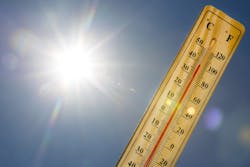SLC 2022 Preview: How to Protect Workers from Heat Stress
EHS Today spoke with Margaret Morrissey, Ph.D., president of the Heat Safety & Performance Coalition, a division of the University of Connecticut’s Korey Stringer Institute, where she is also the director of occupational safety.
Morrissey and co-presenter Matt Block of Magid Glove & Safety will speak at the 2022 Safety Leadership Conference, being held in Cleveland from Oct. 18-20. They will share the latest on heat safety, a perennial concern that has received renewed attention because of recent heat waves and the new National Emphasis Program OSHA launched earlier this year. Below is a preview of what to look forward to this fall.
EHS Today: How will climate change affect the workplace—and workplace safety?
Morrissey: Climate change will increase the likelihood and intensity of exposure to extreme heat, which will increase incidence of developing a heat-related injury and illness.
We've broken lots of heat records this summer. There have been times when one in three Americans was under a heat advisory. What can we expect for workers going forward?
As our changing climate continues to increase the frequency, duration and intensity of extreme heat events, we can expect conditions for workers to get worse, placing them at even greater risk of heat-related injuries and illnesses. There will be an increased need for tailored heat safety interventions to ensure workers across all industries and worksites are protected.
What's a big misconception that workers, safety professionals and/or frontline employees have about working in the heat?
There are many misconceptions that must be addressed. The first misconception is that all heat stress management plans are created equal. For a heat stress management plan to be successful, it must be specifically tailored to the worksite environment. For example, although the “water, rest, shade” model is effective in many ways, there are industries that cannot adhere to this due to their working conditions. This includes worksites in remote settings or workers who are required to wear insulating PPE to protect them for chemical or physical hazards.
A lot of the work we do within the Heat Safety & Performance Coalition (HSPC) is to assist employers [so they can] tailor their heat stress management plans to their specific worksite to reduce the risk of heat-related injuries and illnesses.
The second misconception is related to signs, symptoms and treatment of exertional heat stroke. Exertional heat stroke is a medical emergency that requires the patient to be aggressively cooled within 30 minutes to increase survivability. There is a misconception that cooling modalities, such as ice packs, are sufficient for treatment.
Research has repeatedly shown that if a worker is aggressively cooled through whole-body cold-water immersion—the gold standard treatment—and their core temperature returns to normal levels within 30 minutes, they will survive with no complications. If this time frame is exceeded, it increases their risk of permanent complications or death. Having a cold-water immersion tub or tarp (for tarp-assisted cooling with oscillation) is imperative.
Also, many people believe that a major sign of exertional heat stroke is dry skin. Someone suffering from an exertional heat stroke often does not have dry skin, as they are performing heavy, physical work. This misconception comes from the classic heat stroke, which is a condition that occurs in the absence of any physical activity in populations such as the elderly who have compromised thermoregulatory and cardiovascular function. Dry skin should not be used as a sign of exertional heat stroke.
What would you like to see from federal OSHA?
Due to the increased frequency of heat-related injuries and illnesses in workers, heat stress management must expand beyond “water, rest, shade.” I would like to see OSHA focus on other prevention strategies, such as environmental monitoring, to better protect workers from the dangers of heat. I’d also like them to focus on not only prevention of the heat-related event in the first place but prevention of a fatality if exertional heat stroke occurs.
As many safety professionals know, no safety plan is ever 100% fail-proof. A heat stress management strategy must include an emergency action plan and procedures for exertional heat stroke to avoid a worker dying from a condition that is 100% preventable with best practice treatment.
What projects are you currently working on at the Heat Safety & Performance Coalition and Korey Stringer Institute? Have there been any findings or insights that have surprised you?
We are very fortunate to have many research projects related to occupational heat stress and worker safety and productivity. Our projects span from laboratory studies looking at different heat protection strategies during simulated work in the heat to assessing racial and sex disparities in protection against occupational heat stress.
Within these studies, we were surprised to see the limited use of heat protection strategies across workplaces and the effectiveness of many different prevention strategies on safety and performance outcomes. We are looking forward to sharing this information in future publications to educate our workforce on the impact of prevention strategies and gaps in our current understanding and use of these strategies.
You're pretty active with other groups and committees. What have those conversations been like, and what do you think we can expect from those organizations?
I have been very fortunate to work with many safety stakeholders such as AIHA, ASSP and NIHHIS to create voluntary standards, enhance awareness and address research gaps in our understanding of occupational heat stress.
Following the federal heat stress standard announcement from the Biden administration, many safety organizations have taken the dangers of heat stress very seriously. They have worked tirelessly to address the gaps in implementation of prevention strategies and our understanding of the impact of heat on worker health, safety and productivity.
Conversations among these stakeholders have been positive, and many have joined the fight against heat stress. I hope that organizations continue to focus their efforts on protecting workers from heat and allocate resources to further expand our understanding on its negative impacts.
What's one thing you hope attendees learn from your session at Safety Leadership Conference?
Although it’s difficult to choose one takeaway, I hope that attendees recognize that heat stress is a huge threat to the safety and health of their workers. Implementing a heat stress management plan is mandatory and does not require a significant number of resources to implement, especially with the help of HSPC!
All worksites exposed to heat should include a heat stress management plan that includes prevention strategies and a written heat policy.
About the Author
Nicole Stempak
Nicole Stempak is managing editor of EHS Today and conference content manager of the Safety Leadership Conference.


